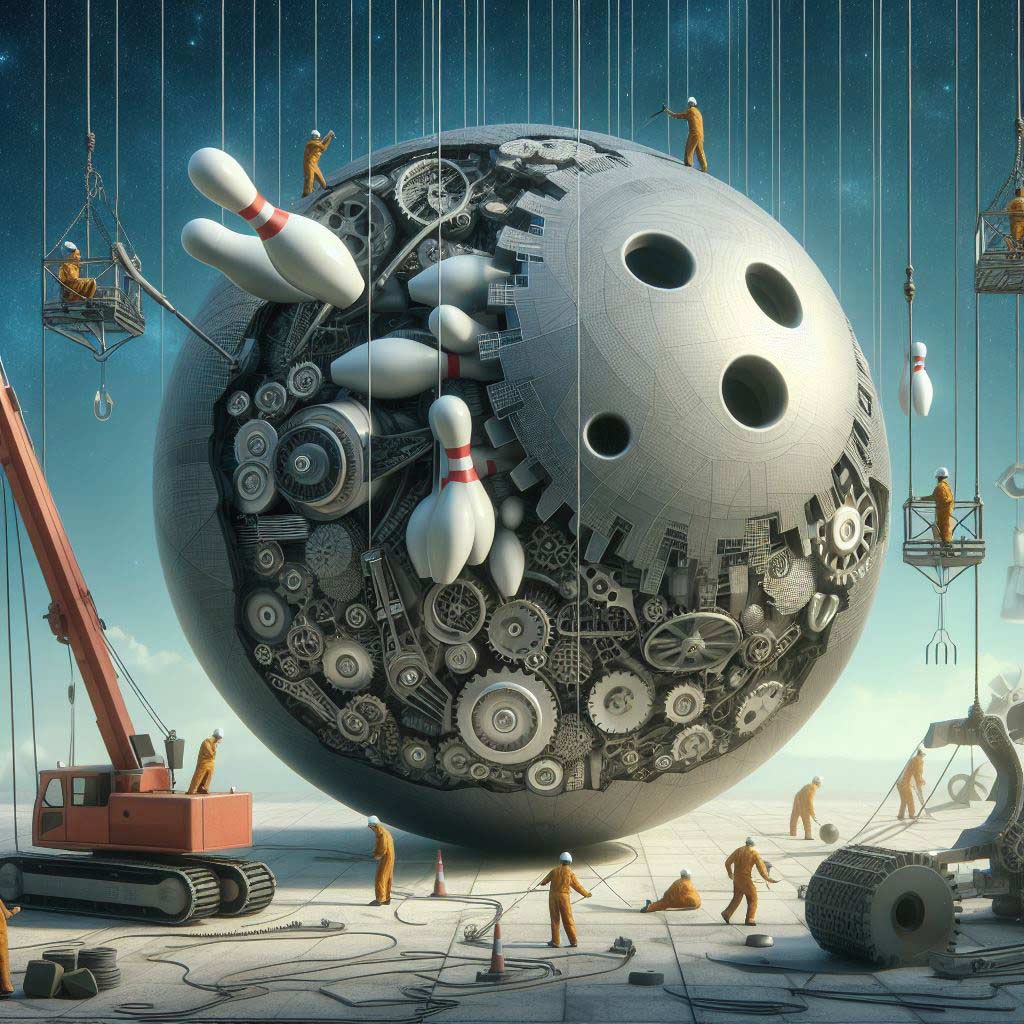Bowling is a beloved sport enjoyed by millions worldwide, from casual players to competitive athletes. At the heart of this thrilling game lies the humble bowling ball – a seemingly simple sphere that belies the intricate manufacturing process behind its creation.
Crafting a high-quality bowling ball requires precision, expertise, and a deep understanding of materials and physics. In this comprehensive guide, we’ll take you behind the scenes and unravel the fascinating journey of how bowling balls are made, from the initial design to the final polish that yields a perfectly spherical masterpiece.
Types of Bowling Balls
Before delving into the manufacturing process, it’s essential to understand the different types of bowling balls available in the market. Bowling balls can be broadly categorized based on their core and coverstock materials.
Core Types:
- Pancake Core: A flat, disc-like core that promotes a straighter ball motion.
- Symmetric Core: A spherical core that provides a predictable and consistent ball reaction.
- Asymmetric Core: An irregularly shaped core that creates more flare potential and backend hook.
Coverstock Materials:
- Reactive Resin: A popular choice for modern bowling balls, reactive resin coverstocks are known for their aggressive hooking potential and oil absorption properties.
- Urethane: Urethane coverstocks offer predictable ball motion and are less susceptible to over/under reactions on various lane conditions.
- Plastic/Polyester: Plastic or polyester coverstocks are the most affordable option, providing a straight ball path and minimal hooking action.
Bowling Ball Core Manufacturing
The journey of a bowling ball begins with the creation of its core. This process starts with the design of molds specific to the desired core shape – pancake, symmetric, or asymmetric. These molds are meticulously crafted to ensure precise dimensions and weight distribution.
The core material, typically a combination of polyester and other high-density materials like wood, is carefully measured and poured into the mold. This process, known as casting, involves heating the materials to a liquid state and allowing them to cool and solidify within the mold’s confines.
Once the core has hardened, it undergoes drilling to create the fingerhole pattern. This step is crucial, as the fingerhole layout directly impacts the ball’s overall balance and performance. Skilled technicians use specialized tools to precisely drill the holes, ensuring optimal weight distribution and consistent ball reaction.
After drilling, the core undergoes a rigorous finishing process, which includes sanding, polishing, and quality checks. This step ensures that the core meets the highest standards for symmetry, weight distribution, and overall quality.
Coverstock Formation
While the core provides the foundation for the bowling ball’s performance, the coverstock – the outer shell – plays a crucial role in determining its overall behavior on the lane. The coverstock formation process varies depending on the material used.
For reactive resin coverstocks, the manufacturing process involves molding the resin material into a spherical shape. This process often involves particle swelling and bonding techniques, where the resin particles are precisely engineered to create the desired density and reaction properties.
Urethane coverstocks follow a similar molding process, with careful consideration given to the material’s unique properties and behavior on the lane.
Plastic or polyester coverstocks, being more affordable options, typically undergo a simpler molding process, ensuring consistent ball motion and durability.
Once the coverstock has been formed, it may undergo an engraving process, where logos, designs, or other visual elements are etched onto the surface. This step adds a personalized touch and enhances the ball’s aesthetic appeal.
Finally, the coverstock undergoes a sanding and polishing process to achieve the desired surface texture and finish. The level of sanding and polishing can significantly impact the ball’s traction and hooking potential, allowing manufacturers to fine-tune the ball’s performance characteristics.
Final Assembly
With the core and coverstock components ready, the next step is the final assembly, where these two essential elements are bonded together. This process, known as adhesion, involves carefully aligning the core and coverstock and applying a specialized adhesive that creates a strong, permanent bond.
Once the adhesion process is complete, the bowling ball undergoes a weight verification process. The ball’s weight is meticulously measured, and static weights (small weights added to the interior of the ball) may be inserted to fine-tune the overall weight to meet industry standards.
After weight verification, the bowling ball undergoes a final finishing process, which may include additional sanding, polishing, or applying a protective coating. This step ensures a flawless surface finish and enhances the ball’s durability and longevity.
Finally, each bowling ball undergoes a rigorous inspection and approval process before being deemed ready for sale. This step ensures that every ball meets the highest standards for quality, performance, and adherence to industry regulations.
Customization Options
While the manufacturing process for bowling balls is highly standardized, manufacturers often offer various customization options to cater to individual preferences and performance needs.
- Core Conversions: Some manufacturers allow bowlers to convert their existing bowling ball cores from one type to another (e.g., converting a pancake core to an asymmetric core). This process involves drilling out the existing core and replacing it with a new, custom-shaped core.
- Custom Hole Drilling Patterns: Experienced bowlers often prefer specific fingerhole layouts to optimize their release and ball reaction. Many manufacturers offer custom hole drilling services, where skilled technicians precisely drill holes according to the bowler’s specifications.
- Engraving Options: In addition to standard logos and designs, many manufacturers offer custom engraving services, allowing bowlers to personalize their balls with unique text, images, or graphics.
- Surface Finishes: The surface finish of a bowling ball can significantly impact its performance. Manufacturers may offer various surface finish options, such as polished, sanded, or textured finishes, to cater to different playing styles and lane conditions.
Bowling Ball Performance Factors
While the manufacturing process plays a crucial role in determining a bowling ball’s performance, several other factors come into play once the ball hits the lane.
- Core and Coverstock Interaction: The interplay between the core and coverstock materials significantly impacts the ball’s overall motion. Symmetric cores paired with reactive resin coverstocks, for example, tend to provide more backend hooking potential, while pancake cores with plastic coverstocks promote a straighter ball path.
- Lane Conditions and Oil Patterns: The amount and distribution of oil on the lane can greatly influence a bowling ball’s performance. Reactive resin balls are designed to absorb and react to the oil patterns, while plastic or urethane balls may perform better on drier lane conditions.
- Customization and Personal Style: The way a bowler customizes their ball, including the fingerhole layout, surface finish, and overall weight, can significantly impact their personal playing style and ball reaction.
Manufacturers continuously innovate and refine their processes to create bowling balls that cater to various playing styles, lane conditions, and performance needs.
By understanding the nuances of core shapes, coverstock materials, and customization options, bowlers can select the perfect ball to elevate their game.
Conclusion
The journey of how bowling balls are made is a fascinating tale of precision engineering, material science, and a deep understanding of the sport’s physics. From the initial core casting to the final polishing touches, each step plays a crucial role in crafting a high-performance bowling ball.
As you’ve learned, the manufacturing process involves intricate techniques such as particle swelling, mold casting, adhesion, and customized surface finishing.
The interplay between the core and coverstock materials, combined with precise weight distribution and fingerhole layouts, ultimately determines a bowling ball’s performance characteristics.
Looking ahead, the bowling industry continues to push the boundaries of innovation, with manufacturers exploring new materials, designs, and manufacturing techniques to create balls that offer unprecedented performance and longevity.
As the sport evolves, the art of bowling ball manufacturing will undoubtedly follow suit, ensuring that bowlers of all skill levels have access to the finest equipment to elevate their game.
So, the next time you step onto the lanes, take a moment to appreciate the incredible journey your bowling ball has undertaken – a journey that combines science, craftsmanship, and a passion for the sport itself.





